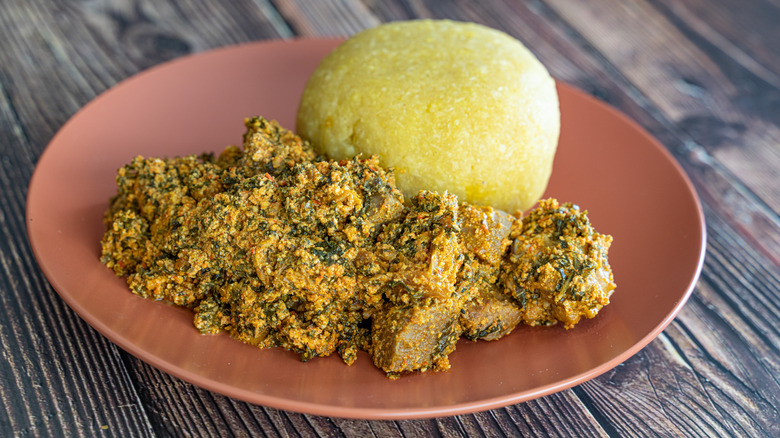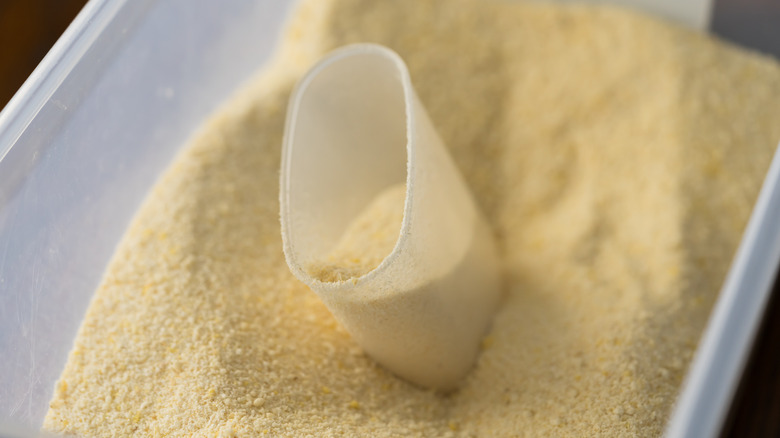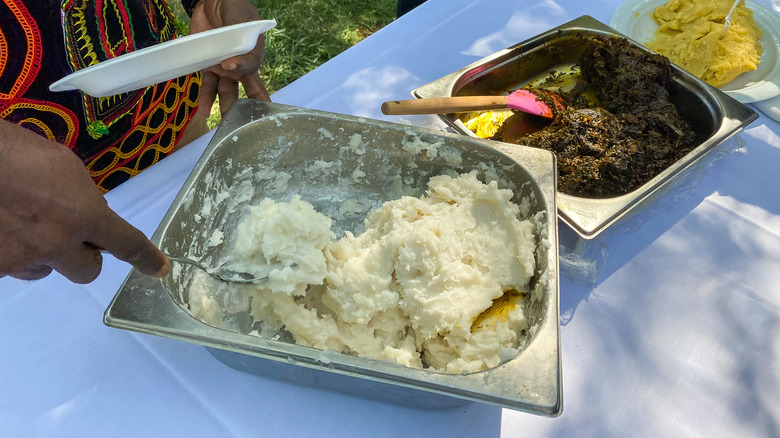Eba: The Nigerian Soft Bread You Should Know About
No matter where you are in the world, one thing is true: Humans love our carbs. You can find tasty breads paired with day-time meals in almost every country around the globe. In India, the famous naan bread is perfect for dipping in spicy curries, and Americans enjoy stocking dinner rolls or garlic bread as a side dish at dinner. However, across West Africa, you can find eba, as a popular "swallow" in the country and the carb-pairing of choice.
Swallows, according to Dobby's Signature, are moldable, elastic, and starchy dough-like side dishes that are usually seen paired with soups and stews. The balls are eaten by breaking off a small piece, dipping it in the soup or stew, and swallowing whole, without chewing, according to Keobi. There are many common swallows that are enjoyed across West Africa, including Iyan, fufu, and amala. All Nigerian Foods notes that there are around 10 common swallows, and eba is the most popular.
History of eba
According to Keobi, the word "swallow" is said to have originated from the Anambra dialect, which is an Igbo language. The word "nni onuno," according to the site, means "swallowed food."
While the word for swallow foods originated in West Africa, the cassava plant itself, from which eba is made, is not native to the continent. The cassava plant is native to South America. The root vegetable was introduced to West Africa during the Colonial period, according to Bon Appetit, when Portuguese invaders were the first to introduce cassava to Nigeria in the 16th century. However, garri, the by-product of cassava used for making eba or cassava meal, did not become popular in Nigeria until the 19th century, reports Bon Appetit. The knowledge of how to make garri was brought to Nigeria when previously enslaved individuals started to return from Portugal, along with the technology for processing cassava, according to the food site.
Today, it's easy to find garri pre-prepared in packaging across Nigeria in grocery stores, according to All Nigerian Foods, and eba has become one of the most popular and commonly made Nigerian swallows.
Ingredients in eba
Across Nigeria, granulated and gluten-free garri is commonly found in homes as a pantry staple. The cassava meal by-product is inexpensive, while also being nutritious, and it is high in fiber and full of essential minerals, according to Bon Appetit.
It also should be noted that the cassava plant produces many other by-products that could easily be confused with garri. For example, other gluten-free pantry items such as tapioca starch and cassava flour are both made from the cassava plant through different processes and have various flavors, textures, and purposes, as per Serious Eats. All Nigerian Foods also notes that there are two types of garri, white and yellow, which can both be used to make eba. The only difference between them is the inclusion of palm oil, which yields the yellower garri.
The process of making eba is simple, can be accomplished in just five minutes, and only requires one other ingredient: water.
How eba is prepared?
The process of making eba is quite simple and very quick. If you're making the garri from scratch, however, it can be a multi-day process. First, as per Serious Eats, the cassava tubers are peeled, grated, bagged, and fermented over many days. The flavor and starchiness of the garri are determined by the length of the fermentation process; shorter fermentations result in a mildly sweet and starchy product, while longer fermentations result in a slightly bitter, less starchy product, says Serious Eats. The resulting wet meal is then thoroughly dried and mixed with a little bit of unrefined palm oil. However, if this process is too intimidating, it is easy to purchase pre-made garri in a package from a West African grocery store.
Once you acquire your cassava meal, you can begin making eba. According to All Nigerian Foods, the first step is to simply boil water, then add the garri slowly into the hot water in a bowl. The mixture will thicken, and at this point you can begin stirring. You can add more product to achieve the desired consistency, as it shouldn't be too soft or too hard, explains the site. Once the eba is mixed well and has a good consistency (dense, slightly heavy, a little sticky, as per Serious Eats), you can remove it from your bowl and serve. The ball should be easy to mold into small bite-sized pieces and can be paired alongside your favorite West African soup or salad.



